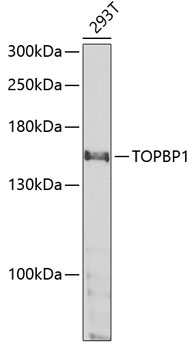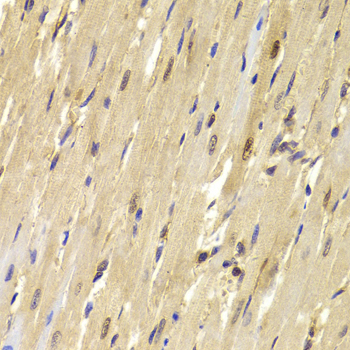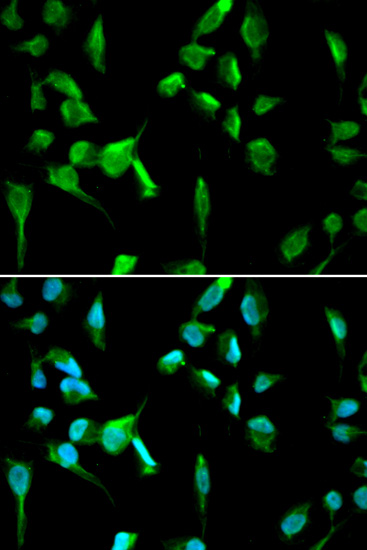-
Product Name
TOPBP1 Polyclonal Antibody
- Documents
-
Description
Polyclonal antibody to TOPBP1
-
Tested applications
WB, IHC, IF
-
Species reactivity
Human, Mouse
-
Alternative names
TOPBP1 antibody; TOP2BP1 antibody; DNA topoisomerase 2-binding protein 1 antibody
-
Isotype
Rabbit IgG
-
Preparation
Antigen: Recombinant fusion protein containing a sequence corresponding to amino acids 1253-1522 of human TOPBP1 (NP_008958.2).
-
Clonality
Polyclonal
-
Formulation
PBS with 0.02% sodium azide, 50% glycerol, pH7.3.
-
Storage instructions
Store at -20℃. Avoid freeze / thaw cycles.
-
Applications
WB 1:500 - 1:2000
IHC 1:100 - 1:200
IF 1:50 - 1:200 -
Validations

Western blot - TOPBP1 Polyclonal Antibody
Western blot analysis of extracts of 293T cells, using TOPBP1 antibody at 1:1000 dilution._Secondary antibody: HRP Goat Anti-Rabbit IgG (H+L) at 1:10000 dilution._Lysates/proteins: 25ug per lane._Blocking buffer: 3% nonfat dry milk in TBST._Detection: ECL Enhanced Kit ._Exposure time: 50s.

Immunohistochemistry - TOPBP1 Polyclonal Antibody
Immunohistochemistry of paraffin-embedded mouse heart using TOPBP1 antibody at dilution of 1:100 (40x lens).

Immunofluorescence - TOPBP1 Polyclonal Antibody
Immunofluorescence analysis of A549 cells using TOPBP1 antibody . Blue: DAPI for nuclear staining.
-
Background
Required for DNA replication. Plays a role in the rescue of stalled replication forks and checkpoint control. Binds double-stranded DNA breaks and nicks as well as single-stranded DNA. Recruits the SWI/SNF chromatin remodeling complex to E2F1-responsive promoters. Down-regulates E2F1 activity and inhibits E2F1-dependent apoptosis during G1/S transition and after DNA damage. Induces a large increase in the kinase activity of ATR.
Related Products / Services
Please note: All products are "FOR RESEARCH USE ONLY AND ARE NOT INTENDED FOR DIAGNOSTIC OR THERAPEUTIC USE"
